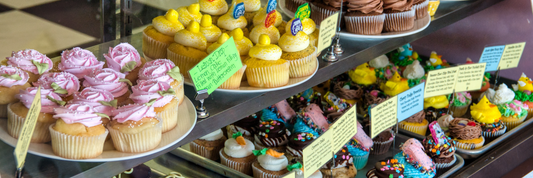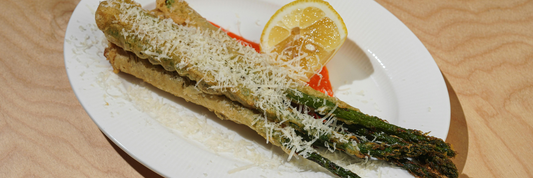Selecting the ideal food wrapping paper plays a crucial role in maintaining food safety, freshness, and enhancing your brand's image. In this article, we'll delve into the diverse functionalities of various food wrapping paper options. By analyzing the advantages and disadvantages of each type, we'll equip you to make an informed decision and select the perfect food wrap for your business needs.
- What is Butcher Paper? Is Butcher Paper The Same As Parchment Paper?
- Should You Choose Wax Paper Sandwich Bags Over the Plastic Bags?
- Is Acid-Free Tissue Paper Better than Regular Paper for your Food Business?
7 Types of Food Wrapping
When it comes to food wrapping paper, there are 7 common types of food wrapping. Below are brief explanation of advantages and disadvantages of each type and their application.
Wax Paper
Wax paper offers a balance of affordability and functionality for specific food applications.
Advantages of wax paper include:
- Moisture resistance: Wax paper effectively protects against minor moisture transfer, ideal for short-term storage of dry or slightly moist foods like sandwiches and some baked goods.
- Grease barrier: The wax coating provides a degree of protection against light grease, making it suitable for wrapping items like pastries or cookies that don't contain excessive oil.
- Cost-effective: Wax paper is generally the most affordable option among food wrapping papers.
However, there are some disadvantages, including:
- Heat sensitivity: The wax coating can melt at high temperatures, rendering it unsuitable for wrapping hot foods or lining baking sheets for greasy items.
- Limited breathability: Wax paper's primary focus is moisture resistance, which can limit breathability. This can trap condensation and lead to spoilage for some foods like fresh breads.
Applications:
- Wrapping sandwiches, bakery items for short-term storage or display.
- Lining baking sheets for dry goods like cookies or biscuits.

Butcher Paper
Butcher paper stands out for its ability to manage moisture in raw meat applications.
Here are advantages of butcher paper
- Breathable: Unlike some moisture-resistant papers, butcher paper allows air to circulate, preventing condensation buildup on raw meats and poultry. This helps maintain freshness and reduces spoilage risk.
- Absorbent: Butcher paper's absorbency helps soak up blood and meat juices, promoting cleaner handling and potentially enhancing food safety.
- Strong and Tear-Resistant: Its robust nature makes it ideal for wrapping bulky cuts of meat without fear of tearing or puncturing.
Disadvantages of butcher paper include:
- Moisture permeability: While allowing moisture to escape, butcher paper itself isn't moisture-resistant. This can lead to drying out of some delicate foods.
- Not greaseproof: Butcher paper is not ideal for highly greasy foods as it won't prevent grease from soaking through.
- Presentation: Butcher paper's primary function prioritizes functionality over aesthetics. It may not be the most visually appealing option for some applications.
Butcher paper is used for wrapping raw meats, poultry, and fish for storage or transport.

Parchment Paper
Parchment paper reigns supreme in the realm of baking and high-temperature cooking, offering a winning combination of functionality and convenience.
Parchment paper offers several advantages, including:
- Greaseproof and heat resistant: Parchment paper excels at handling high temperatures without burning or melting. This makes it ideal for baking cookies, pastries, breads, and even lining pans for greasy foods like pizzas.
- Non-stick properties: Food easily releases from parchment paper, minimizing sticking and simplifying cleanup. This is a boon for bakers and cooks alike.
- Moisture resistance: While not all parchment paper is moisture-resistant, some options offer this added layer of protection, making them suitable for wrapping delicate foods for steaming or grilling.
But, when comparing to some other food wrapping papers, parchment paper can be more expensive. This is the disadvantage of this type of paper.
Parchment paper can be used for many purposes, such as:
- Baking cookies, pastries, breads, and other baked goods.
- Lining baking sheets, trays, and cake pans for various cooking applications.
- Wrapping delicate foods for steaming or grilling.

Foil Wrapping Sheets
Foil wrapping sheets, often referred to as aluminum foil, offer a unique combination of heat conductivity and barrier properties for food storage and preparation.
Advantages:
- Heat conductor and retainer: Foil conducts heat efficiently, making it suitable for wrapping food for even cooking or reheating. It can also retain heat, keeping food warm for transport or serving.
- Moisture and air barrier: Foil acts as a formidable barrier against moisture loss and air exposure, helping to maintain food freshness and prevent spoilage.
- Moldable and versatile: Foil's malleable nature allows it to be shaped around various food items, providing a snug fit and additional protection.
Disadvantages:
- Not breathable: Foil's tight barrier properties can trap moisture and condensation, potentially leading to spoilage for some foods that require air circulation.
- Reactivity with acidic foods: Foil can react with acidic foods like tomatoes or citrus fruits, causing metallic taste or discoloration. Consider alternative wrapping options for these foods.
- Limited rigidity: Foil lacks rigidity and can be easily crushed. It may not be suitable for stacking or storing heavy items.
Applications:
- Wrapping food for transport or storage, particularly cooked or greasy foods.
- Reheating food in ovens or on grills.
- Covering baking dishes to trap heat and moisture during cooking.
- Shielding food from direct heat during roasting or grilling.

Greaseproof Paper
Greaseproof paper excels at handling greasy foods, offering both heat resistance and moisture control.
It has several advantages, including:
- Grease barrier: Greaseproof paper provides a formidable barrier against grease and oil, making it ideal for wrapping fried items, pastries, or greasy take-out food.
- Heat resistant: Unlike wax paper, greaseproof paper can handle hot foods without melting or sticking, offering versatility for various applications.
- Moisture-resistant coating: Many greaseproof papers come with a moisture-resistant coating, creating a double layer of protection for greasy foods that tend to release moisture as well.
Disadvantage of greaseproof paper is limited breathability. While not completely airtight, greaseproof paper's focus on grease resistance can limit breathability compared to butcher paper. This may not be ideal for long-term storage of some foods that require air circulation.
Greaseproof paper is used for:
- Wrapping greasy foods like fried items, pastries, or take-out meals.
- Lining baking sheets for greasy goods like pizzas or heavily oiled dishes.
- Food baskets for greasy or oily items.

Paper Board
Paperboard offers a robust platform for creating food containers and showcasing your brand.
Advantages of paperboard when using as wrapping paper are:
- Strength and rigidity: Paperboard's sturdy nature makes it ideal for constructing boxes and containers that can withstand the weight and potential jostling of various food items. This added protection is crucial for delicate foods like pastries or cakes.
- Branding potential: Paperboard provides a blank canvas for customization. It can be printed with your brand logo, designs, or informative labels, enhancing brand recognition and promoting your business.
However, paperboard has limited barrier properties: Uncoated paperboard is not inherently moisture-resistant or greaseproof. For applications involving moist or greasy foods, additional liners like wax paper or greaseproof paper may be necessary.

Wrapping Paper
While not directly involved with food storage, decorative wrapping paper plays a key role in enhancing visual appeal.
Decorative wrapping paper elevates the presentation of food items, making them more visually appealing for gifting or display purposes.
But it has its own limitations, including:
- Non-food safe: Wrapping paper is not intended for direct food contact and may contain inks or dyes that are not food-safe.
- Limited functionality: Wrapping paper lacks moisture resistance and greaseproof capabilities, making it unsuitable for food storage or transport.
For the reason above, this type of wrapping paper is used for gifting or display purposes only.
Considerations Before Choosing Food Wrapping Paper
Selecting the ideal food wrapping paper for your business hinges on understanding your specific needs. Before explore more about different types of food wrapping paper, here are some factors to consider first:
- Food type: Match paper to moisture, temperature, and grease needs.
- Shelf life: Breathable for short-term, moisture barriers for extended.
- Presentation: Decorative papers elevate gifts; sturdy boxes offer branding.
Understanding these needs will guide you towards the perfect food wrap for your business. In the next section, let’s discover 7 common types of food wrapping paper for your business to consider.
Conclusion
Choosing the right food wrapping paper isn't a one-size-fits-all proposition. By understanding the interplay between your food type, shelf-life requirements, and desired presentation, you can make informed decisions that prioritize food safety, brand image, and customer satisfaction.




